A WiFi analyzer is a tool that helps users evaluate and optimize WiFi networks by detecting signals, analyzing traffic, and identifying potential issues. It scans the surrounding area to detect nearby WiFi networks and displays key details, such as signal strength, channel usage, bandwidth, and potential interference sources. By providing these insights, a WiFi analyzer enables users to fine-tune network settings for better performance, reliability, and coverage.
- Wireless channel analysis: One of the main functions of a WiFi analyzer is channel analysis. In areas with multiple WiFi networks, channels can become congested, leading to slower speeds and interference. A WiFi analyzer shows which channels are in use and suggests less crowded channels to reduce interference and improve connectivity.
- Signal strength monitoring: Another critical feature is signal strength monitoring. WiFi analyzers measure the strength of a network’s signal throughout different areas, which is especially useful in large homes or office spaces. By identifying weak spots, users can adjust router placement or add extenders to ensure better coverage.
- Wireless security monitoring: WiFi analyzers can also help with security monitoring by detecting unknown devices connected to the network, which may indicate unauthorized access.
WiFi analyzers are valuable for both home users and IT professionals, helping ensure optimal network performance, troubleshoot connectivity issues, and maintain a secure, reliable WiFi environment.
Here is our list of the best WiFi analyzers and WiFi Signal Strength Apps for Windows:
- Site24x7 Wireless Monitoring EDITOR’S CHOICE This tool is part of the Network Monitoring features on a cloud-based SaaS platform. Start a 30-day free trial.
- ManageEngine OpUtils (FREE TRIAL) Excels in comprehensive wireless network analysis with an intuitive interface. It’s ideal for real-time monitoring and offers extensive compatibility with various network devices. Start a 30-day free trial.
- NetSpot Built for Windows and Mac OS, this wireless monitoring system includes autodiscovery and live performance maps.
- Acrylic Wi-Fi WiFi analyzer for Windows that is free for home use, but business customers have to pay.
- MetaGeek InSSIDer WiFi analyzer is one of a suite of free tools available from MetaGeek. Sign up for the paid package to get extra features to fix wireless performance problems. Runs on Windows.
- SolarWinds WiFi Analysis with NPM Part of the Network Performance Monitor that runs on Windows Server, this tool shows a live list of WiFi endpoint statuses and generates an amazing wireless signal heat map.
- WiFi Analyzer This tool for Windows is offered for free but has a paid upgraded version. It will tune your live connection and identify other surrounding wireless APs.
- Vistumbler Nifty free WiFi analyzer that can overlay signal footprints on a Google map.
- Wireshark Very well-known wireless packet sniffer that aids hackers and system administrators alike.
Here is our list of the three best WiFi analyzers and WiFi Signal Strength Apps for macOS:
- Netspot WiFi analyzer for Mac OS that includes a heat map facility and an interference assessor.
- WiFi Explorer A mid-level WiFi analyzer for Macs that includes signal strength indicators and noise measurements.
- WiFi Scanner WiFi scanner for Mac OS that is suitable for both business and home users.
Here is our list of the three best WiFi analyzers and WiFi Signal Strength Apps for Linux:
- Kismet Free WiFi analyzer for Linux, Unix, and Mac OS that can be extended by plugins.
- wavemon Free WiFi analyzer for Linux that is available from GitHub.
- Sparrow-WiFi Analyzer WiFi analyzer for Linux that tracks Bluetooth as well and can also employ GPS.
Here is our list of the three best WiFi analyzer and WiFi Signal Strength Apps for Android:
- OpenSignal WiFi and phone signal analyzer for Android that includes geographical maps with signals imposed.
- First Row Network Scanner This app provides a range of tools in addition to a signal detection system. You also get an IP calculator, Ping, TraceRoue, and a port scanner.
Here is our list of the three best WiFi analyzer and WiFi Signal Strength Apps apps for iOS:
- Network Analyzer This free tool provides device discovery and performance tracking for LANs and also signal identification and analysis for wireless networks. Available for Android and iOS.
- Master Network Analyzer WiFi device detector for iOS and Android that includes performance management analytics.
- Fing This app is widely acclaimed and free to use. This tool provides intrusion detection for a wireless network and can detect hidden cameras.
Why use a WiFi Analyzer?
In Brief:
- The Need for Data in Troubleshooting
- Diagnosing Connection Problems with a WiFi Analyzer
- Optimizing Signal Distribution
- Addressing Channel Congestion
- Improving User Experience
Importance of a WiFi Analyzer for Connection Quality
The main reason why you need a WiFi analyzer is to maintain your connection quality. WiFi signals are in a constant state of fluctuation. Your WiFi connection can be performing well until something in the network changes and starts to impede its performance.
The Need for Data in Troubleshooting
Troubleshooting a problem requires data collection and analysis. Without the source information on the normal operations of your network and the current behavior of the troubled system, your solution will be mere guesswork.
Diagnosing Connection Problems with a WiFi Analyzer
When your WiFi starts to slow down or disconnect, a WiFi analyzer will help you to identify the problem. By diagnosing the problem and addressing it, you ensure your connection stays up and running with minimal interference. A WiFi analyzer enables you to run diagnostics on what is happening with your connection and provides you with the information needed to optimize your network.
Optimizing Signal Distribution
For example, if your signal distribution around the house is poor, you’ll be able to use an analyzer to find this information out. That being said, WiFi analyzers can be used for much more than troubleshooting your signal distribution.
Addressing Channel Congestion
You can use a WiFi analyzer to locate and use a less congested channel. Sharing the same channel with nearby devices results in low connection speeds, interference, and disconnection. It’s not uncommon for channels to be shared amongst your neighbors (particularly if you live in an apartment). This is one of the most common reasons for poor connectivity and can be rectified via the use of a quality WiFi analyzer.
Improving User Experience
Using a WiFi analyzer can help improve your user experience, speed up browsing, and eliminate the hassle of trying to guess what factors are impeding your connection quality while troubleshooting. After all, it’s almost impossible to optimize your network if you lack the tools to be able to see what’s going on.
WiFi Heatmap: A Visual Representation of Signal Strength
Many advanced WiFi analyzers will have an inbuilt heatmap function. As mentioned above a WiFi heatmap will produce a visual display of the signal strength in your house. You’ll be able to see where your signal is strongest and choose the best location for your router.
One of the best heatmap tools on the market is the SolarWinds Wi-Fi Heat Map.
Solar Winds allows the user to create custom wireless router heat maps and displays ‘dead zones’ where connectivity is poor. The tool works by reading the signal strength of nearby access points and indicating the quality of your connection based on signal location.
Benefits of Using a Heatmap for Network Optimization
What makes this tool so effective is that the WiFi heat map can produce a physical image of an entire network site. This allows you to easily identify where your site is causing problems for your connection, and what needs to be done to address it. In short, a heat map makes it easier to improve your coverage and signal strength.
The best WiFi analyzers for Windows
Our methodology for selecting WiFi analyzer apps and tools
We reviewed the market for WiFi analyzer apps and tools and analyzed the options based on the following criteria:
- A graphical representation that shows all of the channels within range
- An indicator of signal strength
- Analysis functions that indicate signal overlap
- Alerts to indicate the loss of signal or performance problems
- Identifiers for each access point transmitting signals
- A free tool or a free assessment period
- A good price that is worth paying or a free tool that is worth installing
Features Comparison Table
| Product/Features | Site24x7 Wireless Monitoring | ManageEngine OpUtils | NetSpot | Acrylic Wi-Fi | MetaGeek InSSIDer | SolarWinds Network Performance Monitor | WiFi Analyzer | Vistumbler | Wireshark |
|---|---|---|---|---|---|---|---|---|---|
| Signal Strength Analysis | Yes | Yes | Yes | Yes | Yes | Yes | Yes | Yes | No |
| Channel Interference | No | No | Yes | Yes | Yes | Yes | Yes | Yes | No |
| Graphical Display | Yes | Yes | Yes | Yes | Yes | Yes | No | Yes | No |
| Real-Time Monitoring | Yes | Yes | Yes | Yes | Yes | Yes | Yes | Yes | Yes |
| Compatibility | Cloud based | Windows, Cloud | Windows, Mac | Windows | Windows | Windows | Windows | Windows | Windows, Mac, Linux |
| Coverage Mapping | No | No | Yes | No | No | Yes | No | No | No |
| SSID/Network Information | Yes | No | Yes | Yes | Yes | Yes | Yes | Yes | Yes |
| Exportable Reports | Yes | Yes | Yes | No | No | Yes | No | No | Yes |
| Ease of Use | High | Medium | High | Medium | High | High | High | Medium | Low |
| Free Trial | 30-day free trial | 30-day free trial | Yes (Basic version is free) | Yes | Yes (Lite version is free) | Yes | Yes (Free app) | Yes (Free software) | Yes (Free software) |
1. Site24x7 Wireless Monitoring (FREE TRIAL)
Site24x7 provides its Wireless Monitoring service as part of its Network Monitoring package. This system is more concerned with AP statuses and traffic throughput than signal strength and footprint. The tool is particularly effective on sites that combine both wired and wireless networks.
Key Features:
- AP Status Monitoring: Keeps track of access point availability and performance.
- Traffic Throughput Analysis: Offers insights into data flow across the network.
- Automated Network Mapping: Effortlessly visualizes network topology including wireless components.
Why do we recommend it?
The Site24x7 Wireless Monitoring package is part of a wider Network Monitoring service that is delivered from a cloud platform. The Site24x7 system installs a local agent on a host connected to the network that is to be monitored. This agent performs a discovery routine that will identify wireless equipment as well as traditional switches and routers.
The Network Monitoring service automatically creates a hardware inventory, which will include both your wired and wireless equipment. The package also draws up a network topology map, which will include wireless APs. The Network Monitoring system also tracks traffic volumes through each device.
Who is it recommended for?
This package is suitable for businesses that have both wired and wireless networks to monitor. The tool won’t give you a signal footprint or show where there is channel interference. However, it will show data throughput rates vans when they drop, you know there is probably something wrong with the quality of the signal across your office.
Pros:
- Integrated Network Solution: Part of a broader network monitoring suite, offering extensive coverage.
- Cloud-Based Convenience: Accessible anywhere via a web browser, enhancing remote management capabilities.
- Versatile Monitoring: Suitable for diverse network environments, both wired and wireless.
Cons:
- Lacks Signal Analysis: Doesn’t provide signal strength or interference data, limiting its scope in some scenarios.
- No On-Premise Option: Exclusively cloud-based, which might not align with all organizational IT policies.
Site24x7 markets its platform in plans that include all modules. There are plans to suit a range of needs but they all include the same modules only with different capacities included. You can expand the capacity of any monitoring module by paying for an upgrade. Take a look at Site24x7 by accessing a 30-day free trial.
EDITOR'S CHOICE
Site24x7 Wireless Monitoring is our top pick for a WiFi analyzer app because this cloud-based platform is able to monitor WiFi networks as well as LANs. The Site24x7 package includes a discovery routine that documents all of the hardware connected to your network. That includes wireless APs and the documentation that you get on those access points includes capacity data and other equipment details. The service then performs ongoing monitoring. This package doesn’t produce a heat map or detect coverage. Instead, it focuses on data from the AP and will raise an alert if it detects equipment failure or overloading. The plans of Site24x7 include all of the modules on the platform. The system will also monitor weirs networks, endpoints, software performance, cloud platforms, and website performance. The package also includes log collection and network configuration management.
Download: Access a 30-day FREE Trial
Official Site: https://www.site24x7.com/signup.html?pack=44&l=en
OS: Cloud-based
2. ManageEngine OpUtils (FREE TRIAL)
ManageEngine OpManager is an effective Wi-Fi analysis tool designed for enterprise networks, offering complete control over wireless environments to ensure constant uptime and availability. It simplifies monitoring complex, large-scale IT infrastructures by providing valuable insights into critical networking aspects, which helps quickly detect and troubleshoot emerging network issues.
Key Features:
- Wireless Analyzer: In-depth analysis of wireless networks for performance optimization.
- Real-Time Monitoring: Continuous monitoring for immediate detection of network issues.
- Device Compatibility: Works seamlessly with various network devices.
- Intuitive Interface: User-friendly design for easy network management.
- Comprehensive Reporting: Detailed reports for network performance insights.
Why do we recommend it?
ManageEngine OpUtils is recommended for its robust wireless network analysis capabilities and user-friendly interface. It excels in providing real-time monitoring and extensive compatibility with various network devices. The comprehensive reporting features deliver valuable insights for network performance optimization. Additionally, the prompt alerting system ensures quick identification and resolution of network issues.
The tool features signal monitors to ensure uninterrupted Wi-Fi signals by analyzing metrics like signal-to-noise ratio (SNR) and signal strength. Network utilization monitors track the load on Wi-Fi components, while network traffic monitors oversee traffic metrics like bytes transmitted and received.
Who is it recommended for?
ManageEngine OpUtils is ideal for IT professionals and network administrators seeking a reliable tool for wireless network analysis and monitoring. It’s suitable for organizations needing extensive device compatibility and real-time performance insights. The user-friendly interface makes it accessible for both novice and experienced users. It’s also recommended for businesses aiming to minimize network downtime with efficient alerting and reporting features.
Pros:
- Robust Wireless Analysis: Provides thorough analysis and insights into wireless network performance.
- User-Friendly Interface: The design is intuitive, making it easy to navigate and use.
- Extensive Device Compatibility: Compatible with a wide range of network devices.
- Real-Time Alerts: Immediate notifications for network issues, aiding quick resolution.
Cons:
- Resource Intensive: May require significant system resources, affecting overall performance.
OpManager also automates the discovery, classification, and inventorying of Wi-Fi components, simplifying management for large organizations with multiple access points and wireless LAN controllers.
3. NetSpot
As mentioned above, NetSpot is one of the best programs on Windows and Mac because of its detailed heatmap. The user can upload a map of their location and run a survey with little complication. Once the survey has been completed, the areas where your connection is strongest will be marked in red.
Key Features:
- Intuitive Heat Maps: Simplifies signal strength analysis with easy-to-understand visualizations.
- Detailed Signal Analysis: Offers in-depth insights into signal-to-noise ratios and performance.
- Discovery Mode Insights: Enables comprehensive data compilation from surrounding networks.
Why do we recommend it?
NetSpot offers channel detection and signal analysis. The tool will show you all of the devices that are connected to the wireless network and their traffic. It also provides detailed signal performance information that includes a signal-to-noise ratio and a wireless heatmap that displays signal footprint and strength over a floor plan of your premises.
In NetSpot’s discover mode, you’ll be able to compile data from the surrounding WiFi networks and convert it into a table. On the table, you’ll be able to access information on the SSID, MAC Address, Signal Information, and Vendor.
Who is it recommended for?
NetSpot is a free tool, so it is worth anyone trying The heatmap screen is easy to understand and you might just need that. The signal analysis features go into great detail and so can take time to learn.
Pros:
- Cross-Platform Compatibility: Available for both Windows and Mac, enhancing accessibility.
- User-Friendly Design: Balances technical features with ease of use, ideal for various user skill levels.
- Comprehensive Signal Data: Provides thorough analysis, beneficial for detailed network assessments.
Cons:
- Limited Reporting Functions: Could benefit from expanded data export and reporting capabilities.
- Restricted Free Version: Evaluation version offers limited insights, potentially hindering full assessment before purchase.
Likewise, you can convert this data into a CSV file to create a paper record. The program’s combination of simplicity and technical detail makes it suitable for both home users and network administrators.
4. Acrylic Wi-Fi
Acrylic Wi-Fi is a free wifi analyzer designed for Windows. The user can scan for local wireless routers and compile a table of the relevant details. All the core metrics are included in the table, such as MAC address, SSID, RSSI, channel, and vendor.
Key Features:
- Free for Personal Use: Accessible WiFi analysis tool for home networks.
- Dual Data Presentation: Offers information in both list and graphical formats.
- Flexible Licensing Options: Available as a subscription or one-time purchase.
Why do we recommend it?
Attach a floor plan of your premises to the Acrylic Wi-Fi tool to see a live heatmap that displays the signal footprint and strength from each AP. This tool is a good choice for analyzing signal details because it also provides detailed performance information on each channel and each wireless device in the area.
In addition, the monitor mode allows the user to monitor network packets, which can be used to locate hidden networks. Unfortunately, Acrylic is only free for personal use, and business users will have to obtain the professional version.
Who is it recommended for?
Unless your business is heavily dependent on wireless for network delivery, you probably wouldn’t need a detailed analysis tool like Acrylic for everyday use. Consultants that are frequently called in to analyze the systems of clients would get a lot of use from this tool when loaded onto a laptop.
Pros:
- Enhanced Monitoring Mode: Supports packet capture for deeper network insights.
- Comprehensive Signal Analysis: Detailed performance information for in-depth network assessment.
Cons:
- Complex Interface: Can be overwhelming, especially when analyzing larger networks.
- Initial Setup Challenges: May require a tutorial or additional guidance for new users.
The professional version can be obtained for an annual subscription of $19.95 (£15.07) or a one-time payment of $39.95 (£30.19), which grants the user access to more detailed network information and report generation.
5. MetaGeek InSSIDer
inSSIDer is a free tool produced by MetaGeek. The provider has a number of WiFi management packages that are available for free. A bundle of these tools, called MetaGeek Pro is available with higher functions that include InSSIDer and cost $200 (£151.14) per year. MetaGeek also calls its paid bundle MetaGeek Plus and MetaGeek Complete. The free tool has an attractive interface that shows all wireless signals within range of the host computer. Footprints are shown in a list that can be re-ordered according to each of the displayed attributes.
Key Features:
- Dual Service Tiers: Offers both free and premium versions to suit different needs.
- Visual Signal Representation: Graphical display of wireless network signals for easy interpretation.
- Packet Storage Capability: Higher plans include the ability to save network packets for analysis.
Why do we recommend it?
MetaGeek InSSIDer offers two levels of services and the lower option is free to use. The service identifies each signal within range of the device on which the software is installed and shows it strength. The higher edition provides details on signals that enable troubleshooting.
Selecting one of the entries gets finer details, including signal strength over time in a graph across the top of the screen. The details screen also shows the encryption type used by the AP and the channel of the signal.
Who is it recommended for?
The free version of MetaGeek InSSIDer is a good tool for small businesses, particularly as the MetaGeek website provides guides and tips on troubleshooting and performance improvements for wireless networks. The paid plan is a good choice for larger businesses. It has detailed analysis statistics on a drill-down page.
Pros:
- Real-Time Performance Tracking: Monitors live signal strength and network performance.
- User-Friendly Interface: Simplified and efficient layout for ease of use.
- Accessible to Non-Experts: Suitable for users with limited technical knowledge.
Cons:
- Limited Enterprise Features: Free version lacks advanced tools needed for large-scale networks.
- Restricted Admin Tools in Free Version: The free variant has limited functionality compared to the premium offer.
The free version of insider has great visualizations but not a very extensive range of admin tools. The high version that is available in the MetaGeek Pro package has more capabilities.
InSSIDer installs on Windows and it can be downloaded for free. You can get the MetaGeek Pro package on a 14-day free trial.
6. SolarWinds Wi-Fi Analyzer
The SolarWinds Wi-Fi Analyzer module that comes with the Network Performance Monitor (NPM) will keep your wireless networks ticking over faultlessly. This tool begins its service life with an autodiscovery phase. The AP detection system then continues running to give you live statuses on your wireless networks.
Key Features:
- Integrated Wireless Monitoring: Seamlessly blends wireless and LAN monitoring for comprehensive network oversight.
- Dynamic WiFi Mapping: Automatically creates signal strength maps using uploaded floorplans.
- Advanced Troubleshooting Tools: Includes PerfStack and NetPath for in-depth performance analysis.
- Continuous AP Detection: Keeps track of all wireless access points in real time.
Why do we recommend it?
The SolarWinds Wi-Fi Analyzer is part of a wider network monitoring package. It adds wireless monitoring capabilities onto a LAN monitoring service. This is a useful system both for everyday monitoring and for troubleshooting.
The inventory built up by the discovery phase automatically translates into a map of your wireless devices. You can even generate a wireless heat map by uploading a floorplan of your premises. This will show the signal footprint of all of your wireless APS and helps you see instantly where overlaps and gaps cause service problems.
The NPM tracks the statuses of all network equipment, not just wireless APs, so you will be able to see how your WiFi system fits into your wider network, including remote sites and Cloud services across the internet.
The support given by the Wi-Fi Analyzer highlights WiFi bandwidth issues and performance impairment so that you can quickly resolve network problems and improve service. The screens of the monitor contain live status reports and also include an investigative tool, called PerfStack, which uses drag-and-drop access to let you lay performance monitoring charts on top of each other. This gives you a clear picture of what equipment is the root cause of any performance problems, which you will see ripple through the stack of charts.
An alternative performance management monitor view in the tool is the NetPath screen. This shows you the transition points between all of the links in your network, letting you see the route that signals cross from and to your wireless networks. This is another opportunity to get a visual clue on where performance problems lie.
Who is it recommended for?
This on-premises package is a good service for medium-sized and large businesses because it combines the monitoring of both wired and wireless networks. Performance alerts in the package mean that a network administrator doesn’t have to watch the console all the time in order to catch evolving problems. So, this is a good choice for time-pressed administrators.
Pros:
- Comprehensive Network View: Offers a holistic perspective of both wireless and wired network components.
- Efficient Problem Identification: Root cause analysis tools significantly enhance troubleshooting.
- Live Status Monitoring: Provides up-to-date network performance insights, crucial for maintaining optimal functionality.
- Effective Bandwidth Analysis: Helps in pinpointing WiFi bandwidth issues and improving network performance.
Cons:
- Technical Skill Requirement: Needs some technical expertise for full utilization of its extensive features.
- Windows Server Dependency: Limited to Windows Server environments, reducing flexibility for diverse IT infrastructures.
You can get the SolarWinds Wi-Fi Analyzer module as part of the NPM. It installs on Windows Server and you can access the system software on a 30-day free trial.
You can get deeper analytical capabilities for your network management tasks if you also use the SolarWinds NetFlow Traffic Analyzer. This tool uses the NetFlow, IPFIX, sFlow, J-Flow, and NetStream protocols to extract traffic data from switches and routers. You can get this tool and the Network Performance Monitor in the Network Bandwidth Analyzer Pack.
7. WiFi Analyzer
WiFi Analyzer is a signal optimizer for the current live connection. Users looking for an easy-to-use WiFi analyzer should look no further. The app has been designed specifically for home users and transforms the user’s network into a visual display where they can clearly see their signal strength.
Key Features:
- Wide Platform Availability: Compatible with both Windows and Android devices.
- Vibrant Graphical Displays: Colorful and clear visual representation of network data.
- Popular Choice: Over 1 million downloads, indicating a strong user base.
Why do we recommend it?
WiFi Analyzer is a free tool that will automatically optimize your current wireless connection and it also displays details of other nearby APs. The paid version includes an audible alert for low signal strength.
Like many other apps on this list, WiFi Analyzer is available in both a free and a pro version for $2.99 (£2.15). The free version provides you with all you need to produce graphical displays and identify problems within your network.
The pro version builds on this by providing an auditory beeper for signal strength and the ability to change signal strength borders. As a bonus, the user can also connect straight to a new network via the app.
Who is it recommended for?
WiFi Analyzer is a good choice for home users and small businesses. Its main analysis services are limited to the device that the software runs on. So, it wouldn’t be much help for the network administrators of large businesses who need to gather data across a network.
Pros:
- Flexible Version Options: Provides both a free and a premium version to cater to different user requirements.
- Intuitive User Interface: Ensures ease of use for beginners and non-technical users.
- Audible Performance Alerts: Pro version includes audible signals for performance issues, enhancing user experience.
Cons:
- Limited Large Network Suitability: More appropriate for smaller networks, lacking in-depth analytics for larger setups.
- Simplified Technical Metrics: Focuses on user-friendliness, which might reduce the depth of technical data available.
The simplicity of the user interface and the visual display make this an ideal choice for those new to WiFi analyzer tools. WiFi Analyzer makes it easy to look up available channels on your network and transition to the one that’s optimum.
8. Vistumbler
If you’re looking to run WiFi analytics on a budget, Vistumbler should be your first port of call. This free tool allows the user to locate nearby access points and collect data on their signal strength. When using the platform you can create a unique graph of every network in your vicinity.
Key Features:
- GPS Integration Capability: Enhances location-based network analysis.
- Google Maps Compatibility: Allows for easy visualization of network coverage on maps.
- Dynamic Signal Tracking: Ideal for monitoring moving signal sources.
Why do we recommend it?
Vistumbler uses the wireless transceiver of the device that hosts it and identifies all APs within range. This system is limited to analyzing the AP signals from one location.
Vistumber’s graphs make it easy to identify which networks are performing well, and what you can do to improve your own network performance monitoring. If you’re looking for more of a location-based approach, then you’ll need to add a GPS to your laptop.
If you do this you’ll be able to generate an infrastructure wireless network map over a Google earth image. This means if Vistumbler finds a network it pinpoints it on the map with its accompanying information (name, encryption type, signal strength). The only problem with Vistumber is that it’s not easy to use.
Who is it recommended for?
The Vistumbler system is free to use and it is suitable for home use or in the locations of small businesses.
Pros:
- Cost-Free Tool: Completely free, making it accessible for personal or small business use.
- Automatic Graph Generation: Creates visual representations of network data effortlessly.
Cons:
- Complex User Interface: Might be challenging for non-technical users due to its advanced features.
- Limited Enterprise Applicability: More suited for smaller networks, lacking some functionalities for larger setups.
- Steeper Learning Curve: Requires more time and effort to master compared to other WiFi analyzers.
Vistumbler was originally designed to enable users to search for WiFi networks in moving vehicles, so it’s not tailored toward home or office users. However, once you get past the initial learning curve, it offers more than enough to optimize your network.
9. Wireshark
Wireshark is an open-source packet analyzer and network analysis tool. The system can also be used as a WiFi analyzer tool for Windows, Mac, and Linux. This free program is tailored towards both professional and home users. Wireshark is a powerful network analyzer and has the strength to generate data on an entire office network.
Key Features:
- Detailed Packet Analysis: Offers in-depth examination of network packets.
- File Saving Functionality: Enables data preservation for later analysis.
- VoIP Network Support: Provides specialized analysis for Voice over IP networks.
Why do we recommend it?
Wireshark is a world-famous packet analysis tool and it is great for capturing, filtering, and viewing data packets. As long as packets can reach the device that hosts the Wireshark software, the system will capture and analyze them. This means that it can collect packets from wireless networks as well as LANs.
The system offers live data capture so that you can see real-time network connections and look for connectivity issues. Likewise, you can also run decryption and VOIP analysis to improve the visibility of surrounding networks.
Who is it recommended for?
Wireshark has its own query language for filtering and sorting data. This is a complicated system that takes a long time to learn and so it isn’t really suitable for anyone that doesn’t have technical skills. Systems administrators that have done a course in the usage of Wireshark will really benefit from its analytical power.
Pros:
- Comprehensive Analysis Capabilities: Offers extensive technical insights into network performance.
- Broad Compatibility: Runs on Windows, Mac, and Linux, catering to a wide user base.
- Real-Time Data Capture: Facilitates live monitoring of network activities.
- Integration Potential: Can be part of larger data collection frameworks.
- Free of Charge: Open-source nature makes it accessible without financial barriers.
Cons:
- Complex Configuration for WiFi Analysis: Requires more setup effort to focus on wireless networks.
- High Technical Proficiency Required: Not user-friendly for non-experts, demanding significant technical knowledge.
- Limited Support Resources: Community-driven support with less structured documentation.
The only problem with Wireshark is there’s not much in the way of external support. There’s an active community but little to no supporting documentation to help users with any problems that arise.
That being said, the diverse functionality of the platform offers more than enough to provide home and office users with an industry WiFi standard analyzer suite.
The best WiFi analyzers for MacOS
Features Comparison Table
| Product/Features | NetSpot | WiFi Explorer | WiFi Scanner |
|---|---|---|---|
| Signal StrengthAnalysis | Yes | Yes | Yes |
| Channel Interference | Yes | Yes | Yes |
| Graphical Display | Yes | Yes | Yes |
| Real-Time Monitoring | Yes | Yes | Yes |
| Network Security | Yes | Yes | Yes |
| Compatibility | MacOS | MacOS | MacOS |
| Coverage Mapping | Yes | No | No |
| SSID/Network Information | Yes | Yes | Yes |
| Exportable Reports | Yes | No | No |
| Ease of Use | High | Medium | High |
| Free Trial | Yes (Basic version is free) | No | Yes |
1. NetSpot
When it comes to WiFi analyzer apps for Mac, Netspot is one of the best offerings on the market. Netspot offers a detailed heat map that allows the user to identify signal strength in their surrounding location. The app collects data on everything from channel width, to MAC address, signal quality, and network encryption to provide more transparency over your local network.
Key Features:
- Heatmap Visualization: Offers a detailed view of signal strength across different locations.
- Channel Width Analysis: Analyzes channel widths to optimize network performance.
- Signal Quality Reporting: Provides comprehensive reports on signal quality and network health.
- Interference Detection: Helps identify and resolve WiFi interferences effectively.
Why do we recommend it?
NetSpot offers channel detection and signal analysis. The tool will show you all of the devices that are connected to the wireless network and their traffic. It also provides detailed signal performance information that includes a signal-to-noise ratio and a wireless heatmap that displays signal footprint and strength over a floor plan of your premises.
Unlike many other analyzers, NetSpot allows you to assess WLAN interference as well. What really sets this app apart from the crowd is the depth of its reports, ease of use, and network information. The program color codes areas of signal strength, with weak signals being highlighted by purple or blue.
Who is it recommended for?
NetSpot is a free tool, so it is worth anyone trying The heatmap screen is easy to understand and you might just need that. The signal analysis features go into great detail and so can take time to learn.
Pros:
- Mac Compatibility: Specifically designed for optimal performance on Mac systems.
- In-Depth Network Analysis: Offers detailed insights into WLAN interference and network traffic.
- User-Friendly Interface: Utilizes color-coding for easy interpretation of signal strength and network health.
- Variety of Editions: Available in Home, Pro, and Enterprise editions, catering to different user needs.
Cons:
- Limited Enterprise Use: Not the best option for complex enterprise network environments.
- Challenging Mapping Features: Some users may find the mapping functionalities less intuitive.
- Edition Cost Variation: The pricing of different editions may not suit all budgets, especially for small-scale users.
There are three editions of NetSpot: Home for $49 (£37.02), Pro for $149 (£112.57), and Enterprise for $499 (£377.03). These are the prices for a one-time purchase. The Home and Pro versions are each designed for a single user but the Enterprise edition has the facility to set up ten user accounts. However, the app provides another version where users can scan for local networks and view signal strength data for free.
2. WiFi Explorer
As one of the best mid-level tools on this list, WiFi Explorer is a solid alternative for beginners and experienced users alike. When a user launches WiFi Explorer they can start to locate local wireless networks immediately. Once this occurs, the user can flick through the networks identified via the use of the on-screen tabs.
Key Features:
- Dual-Band Coverage: Covers both 2.4 GHz and 5 GHz channels for comprehensive analysis.
- Signal Origin Identification: Helps determine the best access point by identifying signal origins.
- Graphical Signal Representation: Visual graphs make it easier to understand signal strength.
Why do we recommend it?
Intuitibits WiFi Explorer is designed for Macs and it provides a console that shows a table of detected signals together with a graphical representation. The graph at the bottom of the monitoring screen shows the relative strength of the signal from each detected AP. This enables you to work out which is the best AP to connect to.
Users can look through everything: network details, signal strength, 2.4 GHz and 5 GHz channels. The signal strength tab is WiFi Explorer’s version of the heatmaps seen in other apps like SolarWinds.
You can simply set the app to measure signal strength data and it will produce a graph as you walk around your building. The only drawback is that you won’t be able to detect hidden networks. This is because Apple doesn’t provide the necessary data to detect hidden wireless networks.
Who is it recommended for?
WiFi Explorer is a free tool and is good for home use. Small businesses that run on Macs will be pleased to find this wireless signal analyzer because most of the tools available on the market are built for Windows.
Pros:
- Balanced Functionality: Strikes a good balance between depth of metrics and usability.
- Suitable for Various Networks: Ideal for medium to large size wireless networks.
- Intuitive Interface: Easy-to-learn interface that combines visual and metric data effectively.
Cons:
- Technical Knowledge Required: Some networking knowledge is necessary to fully utilize its features.
- Hidden Network Limitation: Unable to detect hidden networks due to Apple’s data restrictions.
It’s worth mentioning that the app also provides a range of information to assist more experienced users looking for advanced functionality. You can identify information such as the SSID, BSSID, signal-to-noise ratio, and signal quality after you’ve identified another network. Whether you’re looking to break down your network performance or locate a more efficient channel, WiFi Explorer has you covered.
3. AccessAgility’s WiFi Scanner
AccessAgility’s WiFi Scanner is one of the best-kept secrets when it comes to WiFi analyzers. The Mac version of the WiFi Scanner retails at $21.99 (£16.62) and it allows users to analyze their networks download and upload speeds with simplicity. This makes it ideal for home users who don’t have a large budget. There is also a WiFi Scanner for Windows, which has a free trial. The Windows version is much more expensive at $95 (£71.78) per month.
Key Features:
- Cross-Platform Availability: Compatible with both Windows and macOS.
- Intruder Detection: Identifies unauthorized devices on the network.
- Affordable Mac Version: Provides a cost-effective solution for Mac users.
Why do we recommend it?
AccessAgility WiFi Scanner is available for Windows and macOS. The tool detects all nearby wireless signals and provides a graph that shows the relative signal strength of each. Click through tabs for details of all of the encountered networks.
The app breaks down access points in the surrounding area and provides information such as BSSID and MAC addresses. Unlike many other tools on this list, WiFi Scanner also enables the user to detect unauthorized devices on the network through the use of an IP scanner. This makes it a great tool for overall network transparency.
Who is it recommended for?
The fact that this tool runs on a desktop means that it is only good for scanning the immediate environments. That means that it is more suitable for home users and small businesses that only need to scan a single space. A nice feature is that the software runs on Macs and well as PCs.
Pros:
- Competitive Pricing: Attractively priced, especially for the Mac version.
- Rogue Device Detection: Efficient in detecting rogue access points and unauthorized devices.
- Ideal for Small Networks: Best suited for small local area networks (LANs) and home use.
Cons:
- Limited Enterprise Application: Not ideal for large or complex enterprise environments.
- Basic Reporting Features: Lacks advanced reporting and auditing functionalities.
The best WiFi analyzers for Linux
Features Comparison Table
| Product/Features | Kismet | Wavemon | Sparrow-WiFi Analyzer |
|---|---|---|---|
| Signal Strength Analysis | Yes | Yes | Yes |
| Channel Interference | Yes | No | Yes |
| Graphical Display | No | No | Yes |
| Real-Time Monitoring | Yes | Yes | Yes |
| Network Security | Yes | No | Yes |
| Coverage Mapping | No | No | No |
| SSID/Network Information | Yes | Yes | Yes |
| Exportable Reports | No | No | No |
| Ease of Use | Medium | High | Medium |
| Free Tool | Yes | Yes | Yes |
1. Kismet
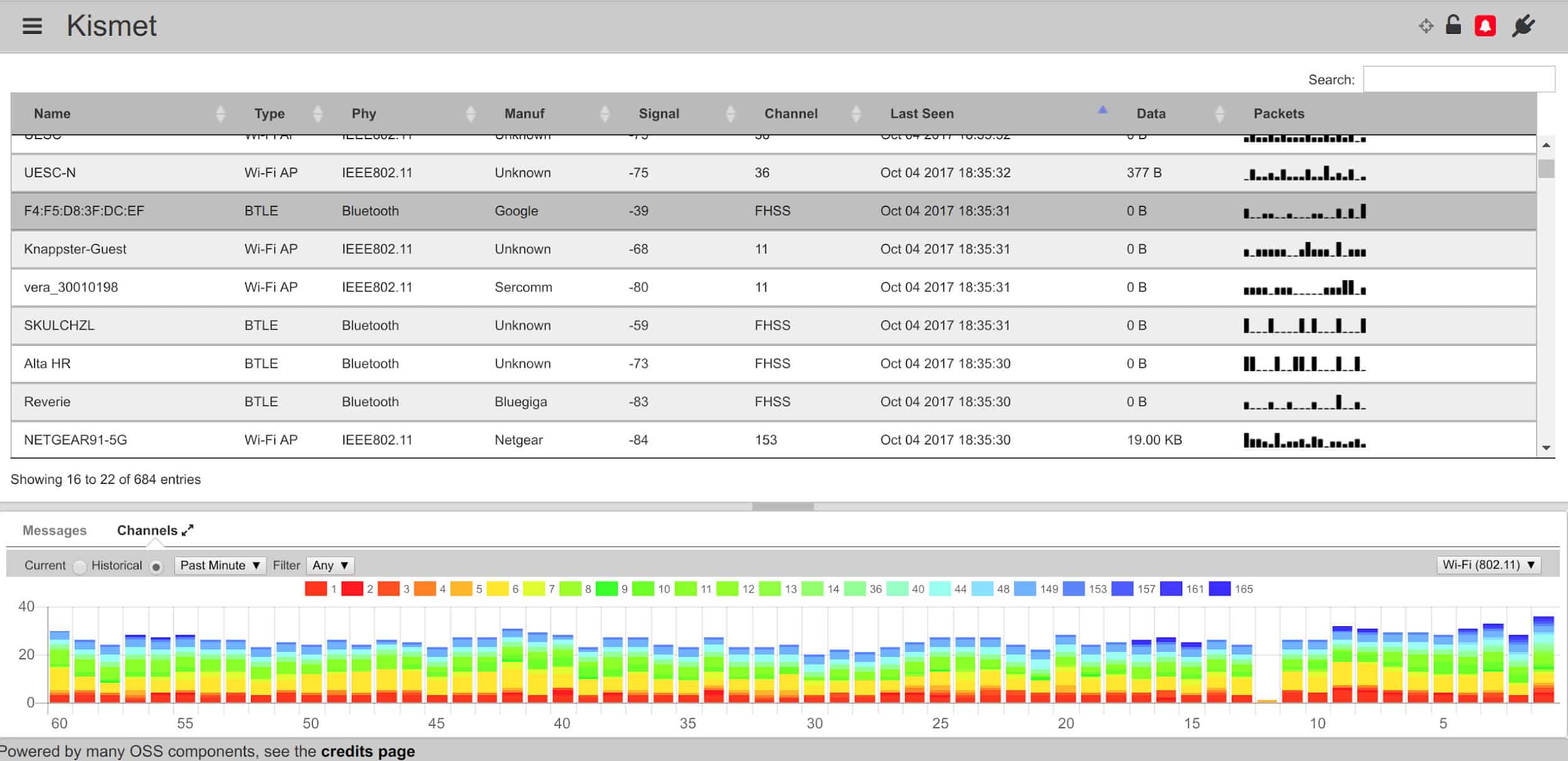
Kismet is a WiFi analyzer or network analyzer designed to work with IEEEE802.11 WiFi cards. Kismet is often used by Linux users but can also be used on FreeBSD, NetBSD, OpenBSD, and Mac OS as well. This tool is widely used because it offers support for a range of protocols including Bluetooth and RTL433.
Key Features:
- Multi-Protocol Detection: Capable of detecting both WiFi and Bluetooth signals.
- Plugin Expandability: Allows for customization with various plugins.
- Real-Time Streaming: Supports live streaming of captures for team collaboration.
- Open Source Flexibility: Free and open-source, enabling user modifications.
Why do we recommend it?
Kismet is able to detect Bluetooth networks as well as WiFi. This is a long-running and well-known free tool. Although it is highly respected, the documentation and guidance on usage is sparse. However, the tool has a rudimentary intrusion detection system and the packets that it captures can be read into Wireshark or Snort for deeper analysis.
The Kismet 2018 version is offering a number of features that enhance the basic functionality of the platform. Now when working with a large team you can conduct real-time live streaming of captures to share information with other colleagues on network activity. If you wish to customize your experience then you can make use of external tool APIs to add additional features.
Kismet has a number of plugins available to expand on the basic product including Kestrel, IoD – Screwdriver, and Elkentaro’s Simplified Mobile Dashboard and ElKentaro’s Simplified Mobile Dashboard.
Who is it recommended for?
You need to be a highly trained technician to get the most out of Kismet. The tool is free to use and is also open source so you can reprogram it if you want to. The system is most useful if you can integrate it into a suite of tools to fully exploit its capabilities. The scanning activities of Kismet are difficult to detect and so it is frequently used by hackers.
Pros:
- Cross-Platform Support: Available for Linux, Mac, and OpenBSD systems.
- Bluetooth and WiFi Scanning: Scans for a variety of wireless protocols, not just WiFi.
- Team Collaboration Features: Real-time packet capture sharing enhances team coordination.
- Lightweight Base Installation: Keeps the core program nimble with optional plugins for extra features.
Cons:
- Not for Large Networks: More suitable for smaller network environments.
- Limited Enterprise Features: Lacks robust reporting capabilities for large-scale enterprise use.
- Community-Dependent Support: Relies on the open-source community for updates and support, which may be inconsistent.
Kismet can be downloaded for free.
2. wavemon
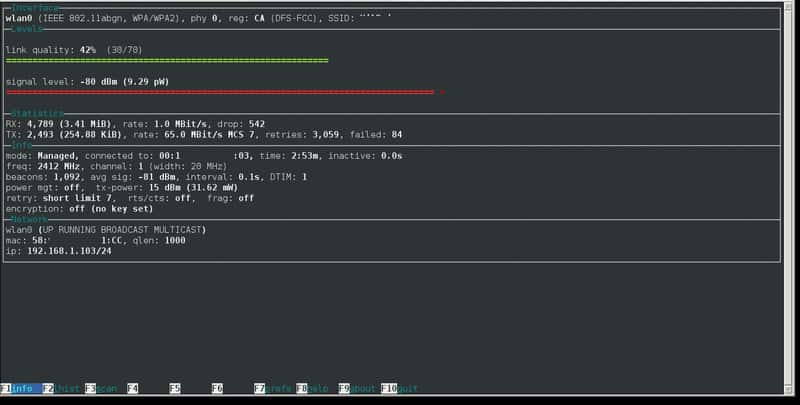
wavemon is a free open source WiFi analyzing tool that allows users to monitor network devices on Linux. To use wavemon, you’ll need to enable wireless extensions. When using a kernel setup with CONFIG_CFG80211 you need to make sure that the CONFIG_CFG80211_WEXT package is activated. You will also want to make sure that you have the pkg-config package.
Key Features:
- Open-Source Customizability: Allows users to tailor the tool to their specific needs.
- Simple Installation Process: Features an autoconf system for easy setup.
- Lightweight and Efficient: Ideal for systems with limited resources.
Why do we recommend it?
The wavemon system is an open-source project and although it is frequently updated, it is built by enthusiasts and does not come with a professional support package. The system is a command line utility so it doesn’t have the pleasing graphics of the other tools on this list. However, it can easily be integrated into scripts for coordination with other utilities.
Once you’ve done this the user experience is quite straightforward. wavemon uses autoconf so that you can make your way through the setup process promptly.
Who is it recommended for?
You certainly need to be an experienced network technician to fully exploit the features of wavemon. This system doesn’t have a graphical user interface and so non-technical users would find this free utility mystifying.
Pros:
- Resource-Efficient Tool: Particularly useful for systems with limited processing power.
- Accessible Setup: Autoconf simplifies the installation, making it more user-friendly.
- Active Open-Source Community: Regular updates and improvements from a dedicated community.
Cons:
- No Graphical Interface: Lacks a GUI, which may deter less technical users.
- Installation Complexity: Can be more challenging to install compared to similar tools.
- Basic Visuals: Lacks advanced visualization features found in more modern tools.
- Dependent on Community Support: Relies on open-source contributors for bug fixes and enhancements.
The program is kept updated on Github so that you can add updates regularly. wavemon is available as source code from GitHub via this link here.
3. Sparrow-WiFi Analyzer
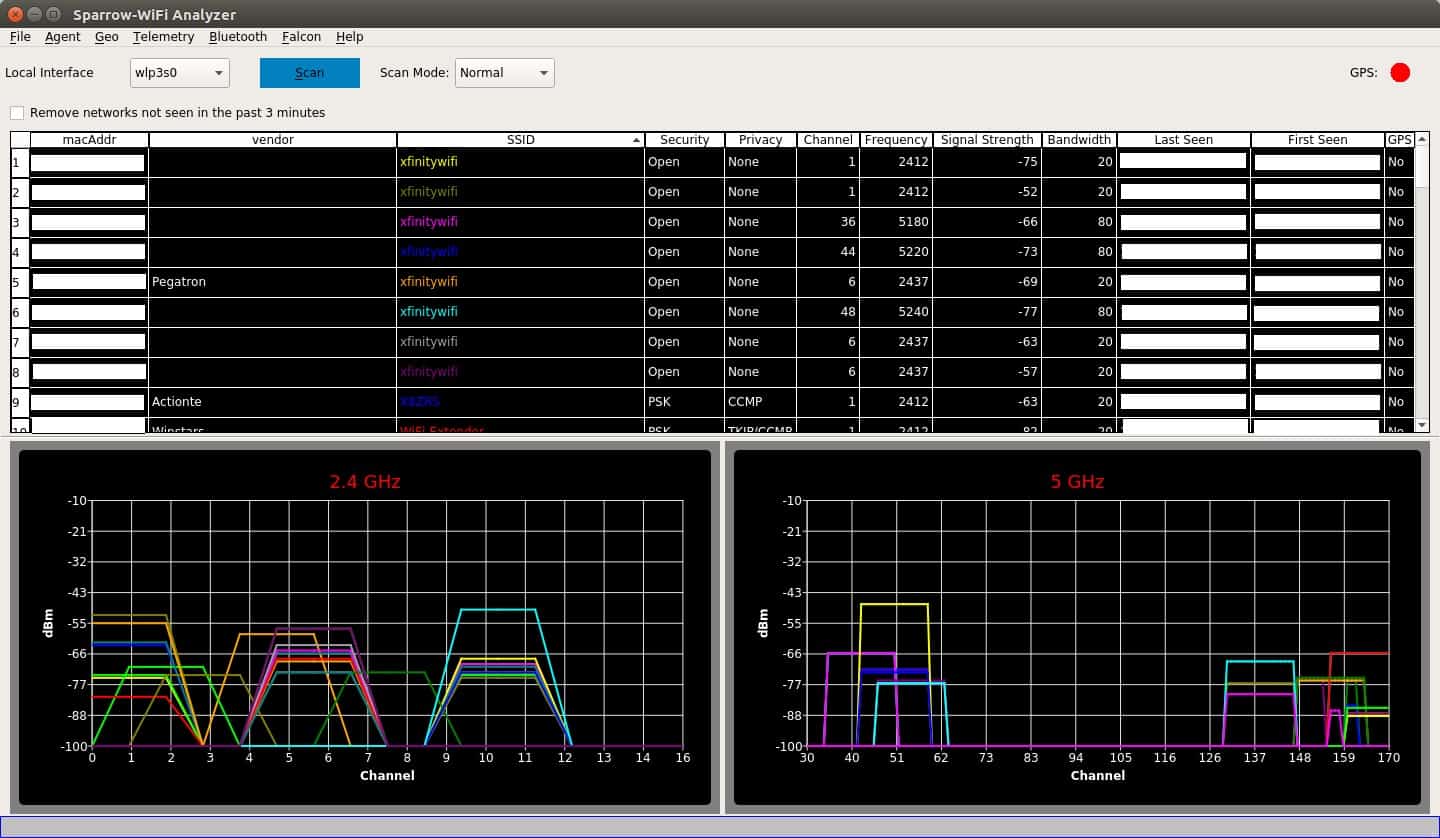
Sparrow-WiFi Analyzer is a 2.4 GHz and 5 GHz WiFi and Bluetooth analyzer for Linux. The sparrow-wifi platform has been positioned as a more GUI-friendly replacement for other tools like inSSIDer and linssid. When using this WiFi analyzer you can conduct WiFi SSID identification and track WiFi sources.
Key Features:
- Dual-Band Analysis: Analyzes both 2.4 GHz and 5 GHz WiFi networks.
- Graphical Data Representation: Offers clear and informative graphs.
- GPS Integration: Enables tracking of WiFi and Bluetooth devices via GPS.
Why do we recommend it?
Sparrow-WiFi Analyzer is almost identical to Kismet, so it would be unfair to recommend that tool and not include Sparrow-WiFi Analyzer on the list. This system is open source and free to use, so you can adapt it if you want. The volunteer development team isn’t as active as the Kismet team and the code is getting a little dated.
The installation process for sparrow-wifi is very simple. On Debian, you will need qtchart and on Ubuntu and Linux you will need to enter a couple of commands to get running:
sudo apt-get install python3-pip gpsd gpsd-clients python3-tk python3-setuptoolssudo pip3 install QScintilla PyQtChart gps3 dronekit manuf python-dateutil numpy matplotlibThere is also the ability to use GPS to track SSID’s and Bluetooth devices. sparrow-wifi enables you to create Google maps that log these for you.
Who is it recommended for?
The target audience for Sparrow-WiFi Analyzer is the same group of technicians that would be interested in Kismet. You need to be knowledgeable about network packet structures and wireless protocols in order to get the best out of this system.
Pros:
- Bluetooth and WiFi Scanning: Capable of detecting and analyzing both network types.
- User-Friendly GUI: Offers a graphical interface for easier navigation and analysis.
- Advanced GPS Features: Allows for precise mapping and tracking of network sources.
Cons:
- Simplistic Interface: The GUI, while user-friendly, may feel basic compared to other tools.
- Targeted at Advanced Users: Best suited for users with in-depth knowledge of network protocols.
- Less Active Development: The development community is not as active as some other open-source projects.
If you need to further analyze your WiFi results then you can also import and export data to CSV and JSON. If you’d like to download sparrow-wifi then you can do so from this link here.
The best WiFi analyzer apps for Android
Features Comparison Table
| Product/Features | OpenSignal | First Row Network Scanner |
|---|---|---|
| Signal Strength Analysis | Yes | Yes |
| Channel Interference | No | No |
| Graphical Display | Yes | Yes |
| Real-Time Monitoring | Yes | Yes |
| Network Security | No | Yes |
| Compatibility | Android | Android |
| Coverage Mapping | Yes | No |
| SSID/Network Information | Yes | Yes |
| Exportable Reports | Yes | No |
| Ease of Use | High | Medium |
| Free Trial | Yes (Free app) | Yes (Free app) |
1. OpenSignal
OpenSignal is one of the most versatile apps on this list. You can see your WiFi signal strength and coverage on a virtual display and run speed and latency tests. What really sets OpenSignal apart is its detailed maps system. You can view a map of WiFi hotspots and phone towers to see where network connection quality is best. It’s worth noting that the phone towers are shown only pertain to your telephone provider.
Key Features:
- Geographic Signal Mapping: Maps WiFi and mobile signals on a real-world map.
- Mobile Network Monitoring: Also monitors mobile signal strength and coverage.
- Comprehensive Speed Tests: Includes latency and speed test functionalities.
Why do we recommend it?
The OpenSignal cellphone network analysis tool is a free gift from an industry consultancy. This utility doesn’t show you the wireless signals around you, rather it tests the wireless network that you are connected to. It is specifically designed for the analysis of wireless services on phones and it is also available for iOS. A great feature of this signal checker is a live map that shows the nearest cell towers of your phone network provider.
OpenSignal is the best choice for users looking to monitor both their wifi and mobile devices’ signal coverage. Of course, you can still generate extensive wireless network information if you are looking to stick to the fundamentals.
Who is it recommended for?
If you use your mobile data plan a lot and need to be sure that you are getting food service, this tool is for you. This is more appealing for personal users than businesses. One problem with this tool is that it gathers information about your cell phone and its usage even when you don’t have the app open. The company uses the free tool as a data gatherer for its cell market analysis activities, comparing live statistics of each phone operator with that provider’s claims.
Pros:
- Dual Signal Analysis: Capable of analyzing both WiFi and cellular signals.
- Interactive Geographic Maps: Offers a visual map to locate networks and hotspots.
- Integrated Speed Testing: Allows for direct speed and latency testing within the app.
- Ad-Free Experience: Free to use without the interruption of advertisements.
Cons:
- Not for Enterprise Use: More suitable for personal use rather than business environments.
- Limited WiFi Analysis: Focuses more on cellular networks than in-depth WiFi analysis.
- Lacks Desktop Version: Does not offer a comprehensive desktop application for broader analysis.
This app is also competitive in terms of price, being available for free with no onboard advertisements.
2. First Row Network Scanner
Network Scanner from First Row is a handy package of tools for examining wireless networks and the devices that connect to them. This tool shows you the other devices that are connected to the wireless network that your Android device is also connected to rather than showing all of the available access points in the area.
You don’t get signal strength meters or nice graphs with this tool. However, you do get details on each device, such as its manufacturer and its allocated IP address on the network.
Key Features:
- Device Identification: Lists and identifies devices connected to a WiFi network.
- Detailed Device Information: Provides in-depth details about each connected device.
- Built-In Port Scanner: Includes a port scanning tool for network security checks.
Why do we recommend it?
Network Scanner doesn’t show you all the WiFi networks within range of your device. Instead, it focuses on the network that your device is connected to and identifies all of the other devices that are connected. This is a useful tool for company technicians or home users to detect rogue devices connected to the WiFi network.
The extra tools in with this scanner make this a wireless network troubleshooting toolkit. You can check on the speed of your network and move around the office looking for blindspots and weak signal areas. While network performance monitors tend to be hosted on desktops, the mobility afforded by the Android hosting of this system makes a better system for managing wireless signals.
Who is it recommended for?
This app is a great tool for home users and any on-site technician. Remote IT asset management teams won’t get any use out of this system. It should be used to work out where best to position wireless APs in a space to get maximum coverage and also make periodic checks on rogue devices, which, admittedly, could also be performed by remote monitoring systems.
Pros:
- Effective Device Management: Helps in managing and monitoring devices on a network.
- Rogue Device Detection: Useful for identifying unauthorized devices on a network.
- Ideal for WiFi Optimization: Assists in determining optimal placement for wireless APs.
Cons:
- Limited Network Scanning: Does not display all wireless networks in an area.
- No Signal Strength Meter: Lacks a feature to measure and display signal strength.
This is a useful free tool for wireless network troubleshooting.
The best WiFi analyzer apps for iOS
The iOS operating system blocks access by apps to the WiFi processes or network connection hardware. That presents a big problem for the designers of wireless packet sniffers. However, some valiant system software producers have taken a shot at producing WiFi analyzers for iPhones and iPads.
Features Comparison Table
| Product/Features | Network Analyzer | Master Network Analyzer | Fing |
|---|---|---|---|
| Signal Strength Analysis | Yes | Yes | Yes |
| Channel Interference | Yes | No | No |
| Graphical Display | Yes | No | Yes |
| Real-Time Monitoring | Yes | No | Yes |
| Network Security | No | No | Yes |
| Coverage Mapping | No | No | No |
| SSID/Network Information | Yes | Yes | Yes |
| Exportable Reports | No | No | Yes |
| Ease of Use | High | Medium | High |
| Free Tool | Yes | Yes | Yes |
Check out the following options:
1. Network Analyzer
Network Analyzer does a good job of presenting network information within the constraints of the iOS operating system. The service is produced by Technet and is available in two versions. New users can only download and install the free editions, which is called Network Analyzer Lite.
Key Features:
- Signal Strength Display: Clearly shows the strength of network signals.
- Transmission Time Measurement: Measures round-trip response times to nearby devices.
- Cell Network Insights: Offers detailed information about cell networks in addition to WiFi.
- Version Variety: Available in both free and paid editions for user choice.
Why do we recommend it?
Network Analyzer from Jiri Techet is a neat little mobile app packs a punch because it can perform LAN network analysis as well as wireless signal tracking. There is a paid version available called Network Analyzer PRO. This tool is also available for Android.
The tool includes a Wi-Fi LAN scanner, which spots all network devices on a wireless network. The tool shows the round-trip response time to each detected device, using Ping. It can also deliver the IP address of each device and show the device’s location with a flag icon. The scan can also tell you the cell network details of each device within range and other wireless network data.
Who is it recommended for?
Network Analyzer is suitable for personal use. It could be used by a consultancy for quick network traceroute tests or local Wifi speed tests. It would also be a good tool for a small business.
Pros:
- Versatile Analysis Tools: Offers a range of tests including latency, jitter, and response time calculations.
- Comprehensive Network Tracking: Capable of tracking both WLANs and external IP addresses.
- Cellular Network Data: Provides valuable statistics for cellular networks.
- User Choice: Availability of both free and premium versions caters to different user needs.
Cons:
- Complex Dashboard: The interface could be more user-friendly and easier to navigate.
- Limited Layer 3 Support: Could benefit from incorporating Layer 3 Netflow traffic support.
Once you have Network Analyzer Lite installed on your iPhone or iPad, you have the option to upgrade to the full version. Network Analyzer shows connection details with the route displayed on a world map. It will also give you network speeds to reach various locations around the world, not just ping details on your current wireless network.
2. Master Network Analyzer
Master Network Analyzer detects details of the current wireless network that the iOS device is connected to and also offers a series of tests for the network and any connections made from the device.
Key Features:
- Connection Quality Assessment: Tests and evaluates the quality of network connections.
- Signal Strength Analysis: Detects and displays the strength of the current WiFi signal.
- Free Availability: Accessible at no cost to the user.
Why do we recommend it?
Master Network Analyzer is an attractive tool that offers performance tests and analysis for the wireless network that the host device is connected to rather than scanning all nearby networks. This tool isn’t available on the Apple Apps Store or on Google Play, so you have to get it from the producer’s website at the link in the title of this review.
The scanner details network information, such as the gateway IP address, DNS server IP address, the device’s allocated IP address on the network and the network’s IP address for the outside world. It will also show all other devices connected to the same wireless network and give information about each of those.
Analysis and connection testing utilities in the tool include ping, traceroute, a speed test, a DNS lookup, and a Whois feature.
Who is it recommended for?
Master Network Analyzer is a handy free tool for personal use and system administrators that manage a fleet of mobile devices could also use it to test that newly onboarded devices were functioning properly before handing them over to users.
Pros:
- Intuitive User Interface: Offers one of the more user-friendly interfaces for iOS WiFi analyzer apps.
- In-Depth Device Data: Extracts detailed DNS, gateway, and IP address information.
- Basic Network Testing: Includes functionalities like whois lookups, traceroute, and speed tests.
- Multi-Platform Support: Available for both iOS and Android devices.
Cons:
- Primarily for Personal Use: More suitable for individual rather than enterprise needs.
- Basic WiFi Testing: Lacks advanced features for in-depth WiFi analysis.
The Master Network Analyzer Pro tool is free to use and it is available for Android as well as for iOS. This app is probably more appropriate for personal use than for businesses. However, individuals in a business who need to travel to other sites and locations, such as sales agents of craftsmen, might find it useful.
3. Fing
The Fing app has been downloaded 40 million times and it is free to use. This is one of the most widely used wireless network monitoring tools available for iOS devices. The tool won’t scan for all wireless signals, just those devices that are connected to the same WiFi network that the host device is using.
Key Features:
- Intrusion Detection System: Identifies unauthorized access to the network.
- Router Vulnerability Scanning: Scans for vulnerabilities in wireless routers.
- Hidden Camera Detection: Unique feature to detect undisclosed cameras.
Why do we recommend it?
Fing has a large user community, which is a good source of usage tips for new users. The service offers vulnerability scanning, which is a rare feature in on-device WiFi analyzers and is more commonly found in expensive network security packages. The security services of this tool are bundled in with troubleshooting systems, such as a speed test utility.
The unique features of Fing include a camera detector, so you can sweep your home or office for unknown spying devices – a crucial security step in these days of internet snooping and peepers.
Businesses can use a module of the package, called Fingbox, to ban devices from accessing offensive or leisure websites at work and it can also be used to log exactly who is on the business premises, which provides an automated timesheet checker.
Who is it recommended for?
Fing is a useful tool for both home use and for businesses. The Fingbox unit is more of a business tool because it provides controls over employees and their activities. However, the ability to ban access to types of websites is also useful as a parental control mechanism.
Pros:
- Large User Community: Benefits from an active user base for tips and support.
- Advanced Security Features: Includes rare features like vulnerability scanning.
- Business and Home Utility: Useful for both personal and business environments.
- Network Troubleshooting Tools: Offers a suite of tools for WiFi network troubleshooting.
Cons:
- Network Limitation: Only analyzes the network the device is currently connected to.
As a free tool, Fing is hard to beat. The service is ad-supported but you can get rid of that minor inconvenience by paying a small fee for the app.
WiFi Glossary
dBm – dBm stands for decibel-milliwatts. dBm is the measurement used to measure the strength of a WiFi signal.
IP Address – A unique number punctuated with full stops used to identify a computer communicating via a WiFi network.
MAC Address (Media Access Control Address) – A unique identifier used to refer to a network adapter over a network.
RSSI (Received Signal Strength Indicator) – A measurement used to identify the strength of a radio signal.
Signal to Noise Ratio – The ratio of an electrical signal’s strength compared to outside interference.
SSID (Service Set Identifier) – The technical name for a WiFi network name.
Vendor – A wireless network provider.
WiFi Channels – A WiFi channel is where WiFi networks exchange data (Channels 6 and 11 are where most routers exchange data).
Wireless Access Point (WAP) – A hardware device or configured node on a local area network that allows wireless devices to connect through WiFi and Bluetooth connections.
WLAN (Wireless Local Area Network) – A network that allows devices to connect, interact and communicate with each other wirelessly.
How to get a better signal and connection using a WiFi analyzer?
Whether you’re a home user or a battle-tested network administrator, a WiFi analyzer is a vital tool for managing your network. If you want to maintain the connection speed and integrity of your WiFi connection, then a WiFi analyzer app should be a high priority.
There are plenty of different options available on the market. If you want to have full WiFi coverage it’s a good idea to look for a model with an inbuilt heat map, as this is the most effective way to see a real-time depiction of your local signal strength.
Ultimately you’re looking for an app that’s easy to use and offers the functionality needed to achieve your needs. A home user might be able to scrape by on a free program, but an entire department will need a more powerful solution.
Taking some time to research the right tool for your business will allow you to optimize your online experience much more effectively. Whether you’re a home or enterprise user, doing your research is the key to finding the WiFi analyzer app that’s right for you.
WiFi Analyzer App FAQs
What are the best channels for my wireless router?
In the 2.4 GHz band, channels 1, 6, and 11are the best options for a router because they do not overlap with other channels.
What channel is best for 5GHz?
In the 5GHz band, channels 36, 40, 44, and 48 are reserved for domestic use and so do not overlap with bands used for commercial, weather, or military purposes.
Should a wifi extender be on the same channel?
Yes. You should have your WiFi extenders on the same channel as your router. However, to avoid confusion at times when you want to analyze signal strength give each extender a different SSID that is also different from the one assigned to the WiFi router.
See also: The Best WiFi Stumblers

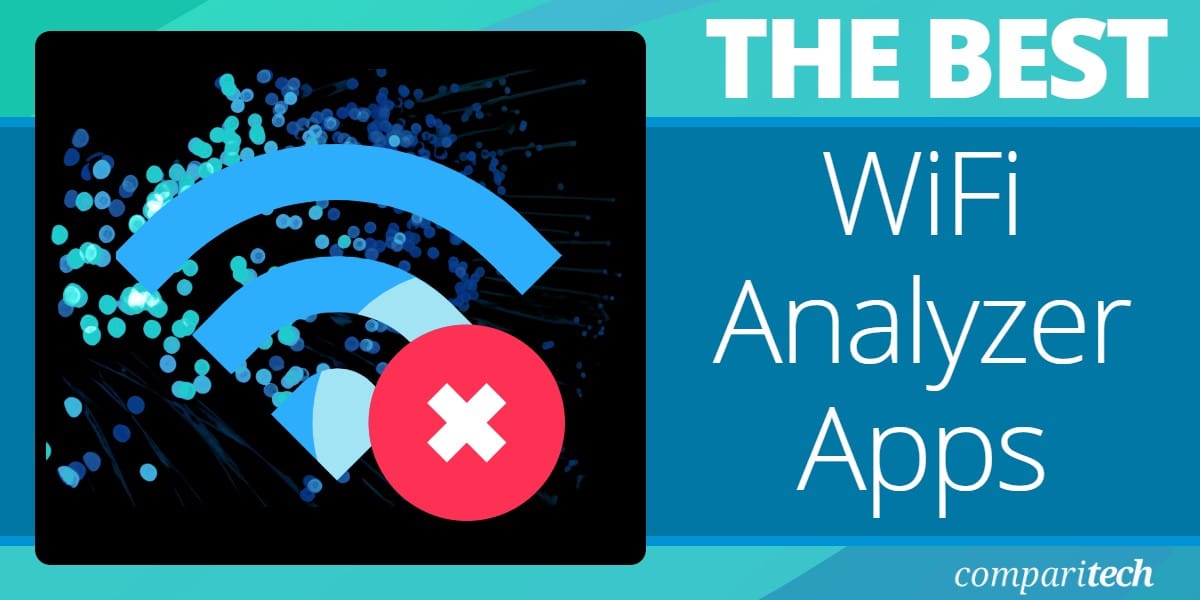



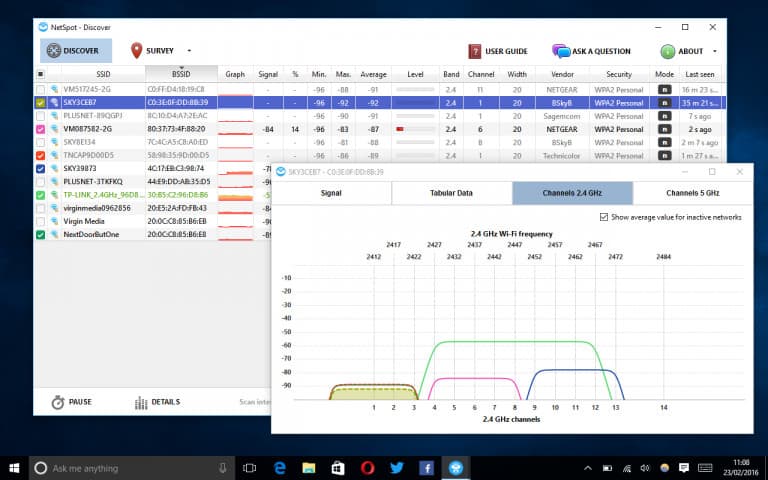

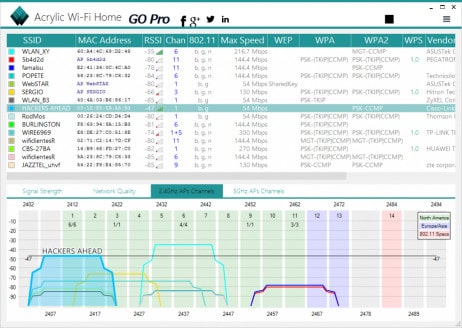

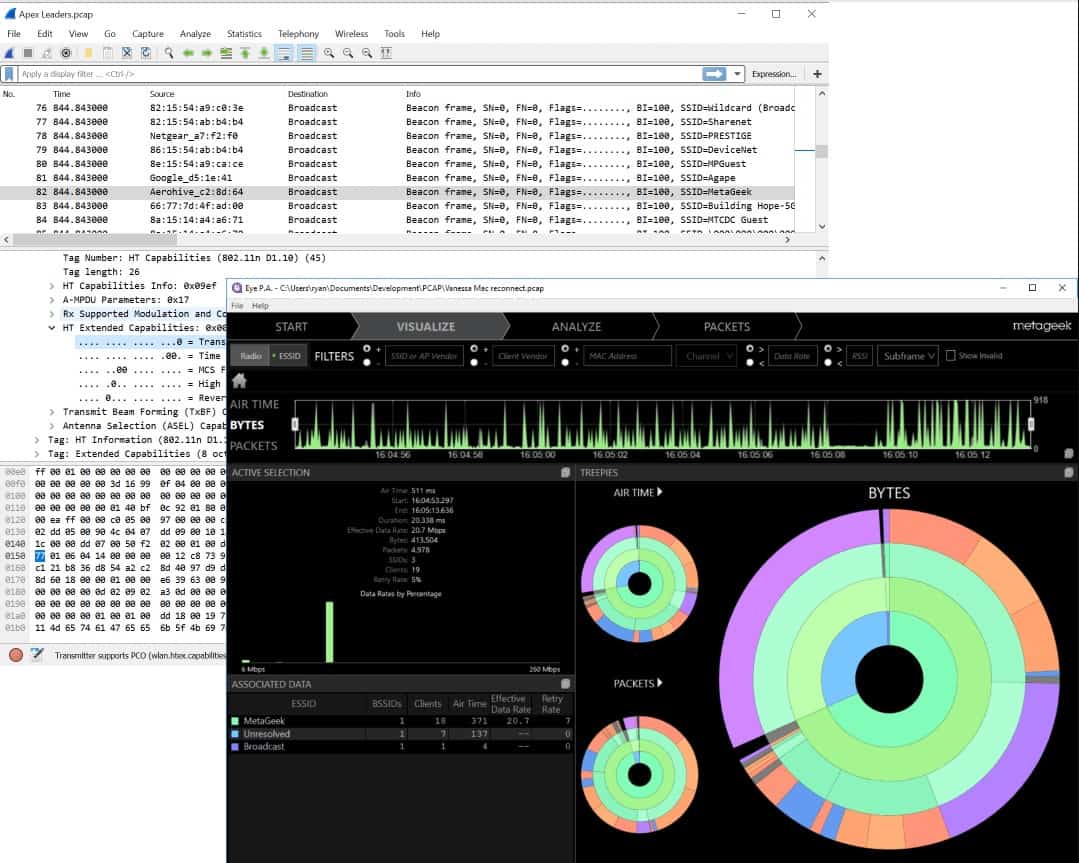

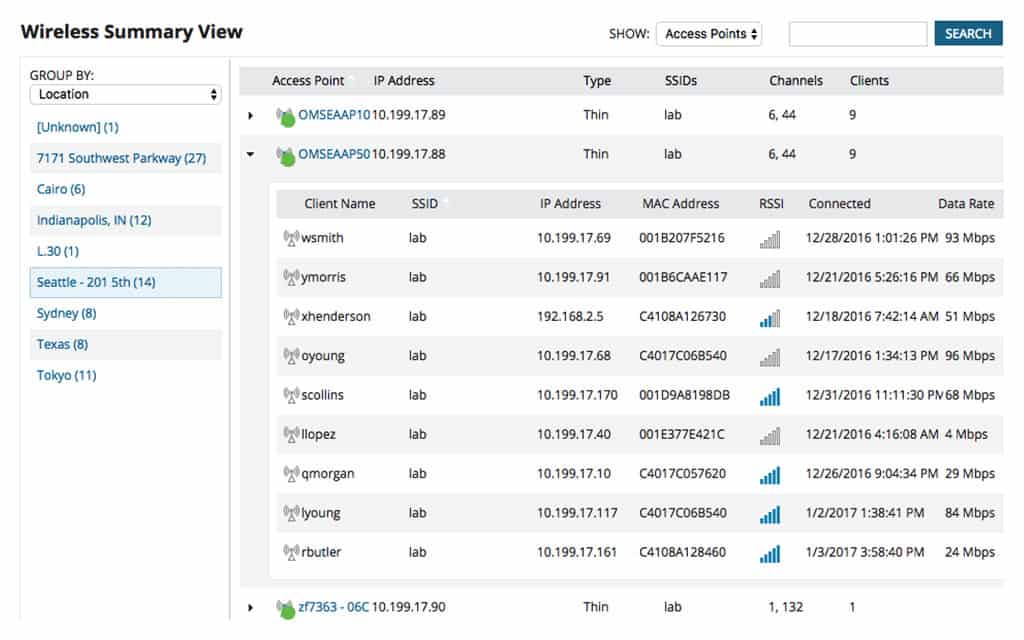
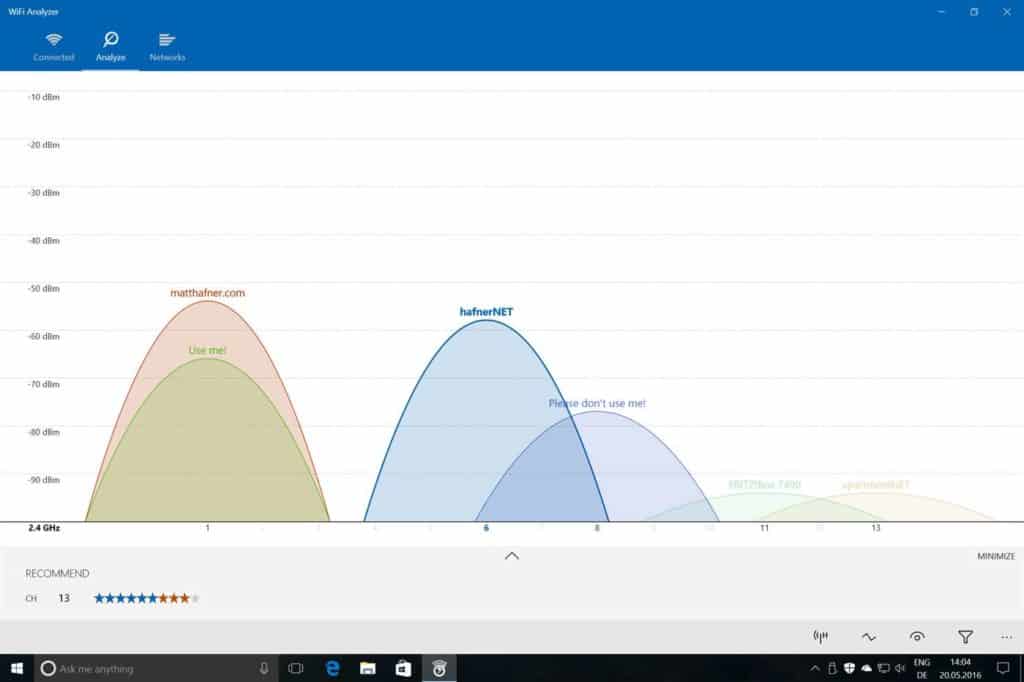

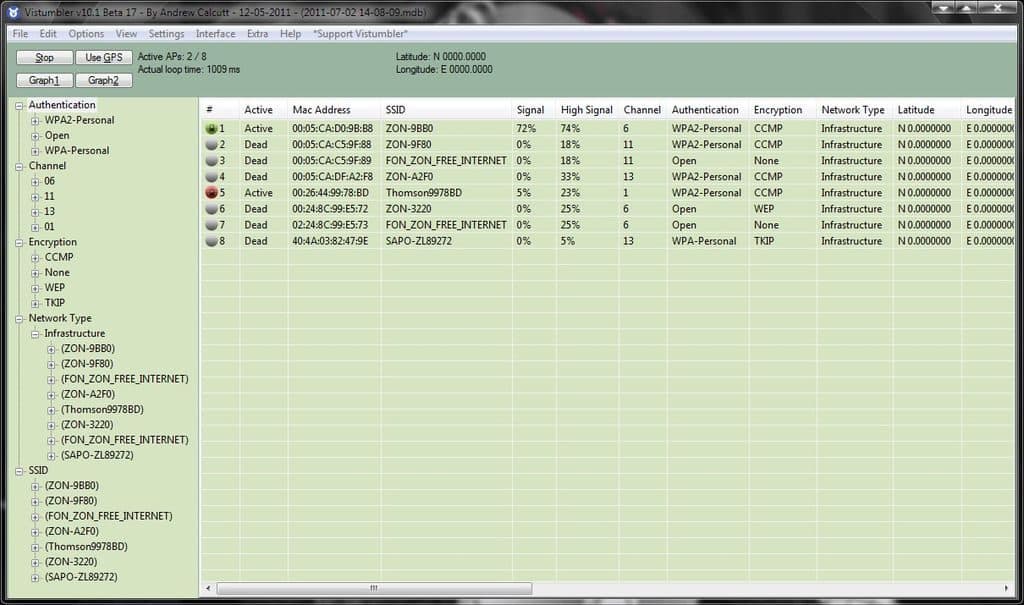

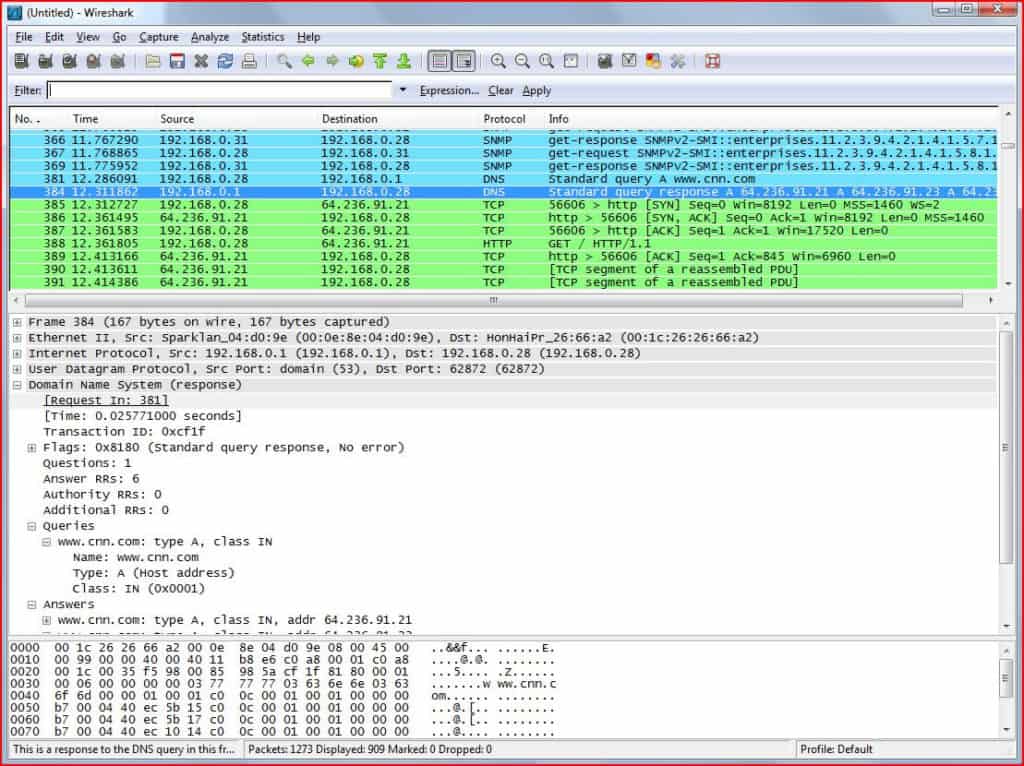

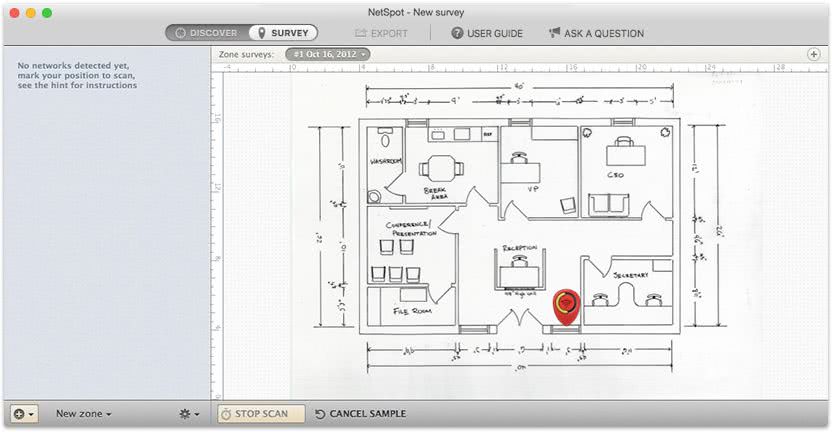

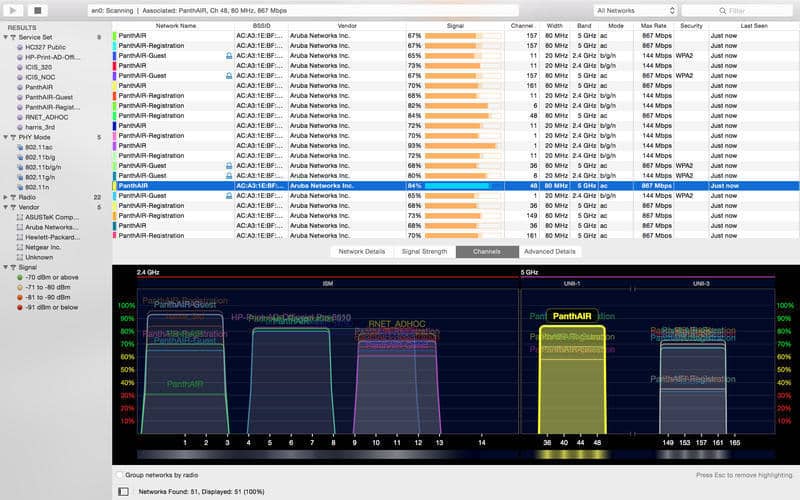

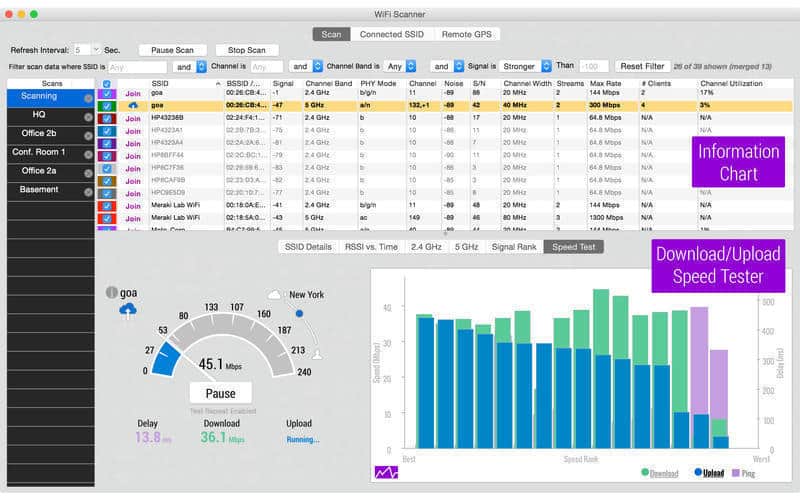









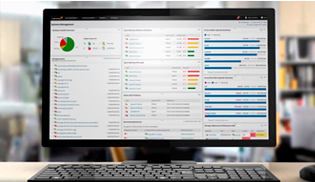
I like to try different apps to find out which ones really work.
Your article title mentions Linux but there is no separate list for Linux – only MAC, Windows and Android.
Also, Wireshark isn’t a WiFi analyser per se – its purely a packet analyser (admittedly an excellent one).